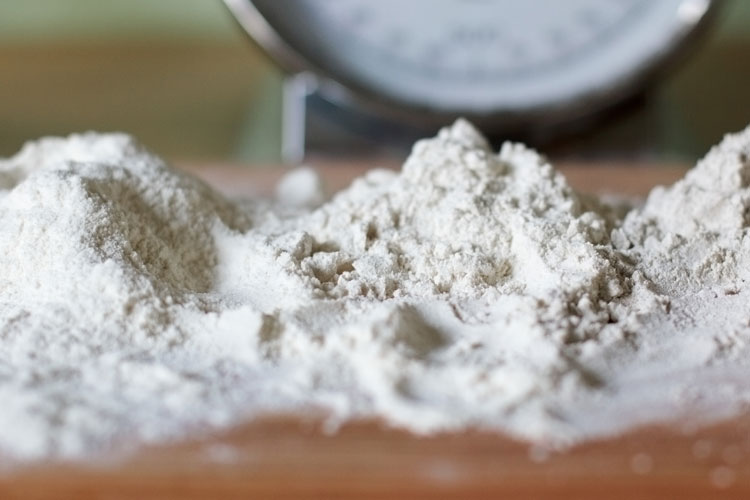Flour is the term used for the powdery substance resulting from the grinding, milling or pulverizing of grains, seeds, roots or other edible materials. Wheat, rye, oats, rice, corn, taro root, and cassava are some examples of grains and roots that are ground into flour, primarily for baking. Flour is the main ingredient in bread, which is a staple food in most cultures.
Flour contains amylase, an enzyme that can trigger allergic rhinitis --- or hay fever --- when inhaled by humans. It can even cause asthma attacks in some individuals.
Flour is Combustible and is an Explosion Hazard:
When most people think of controlling dust in the workplace, they think of taking steps to avoid inhaling dusts to prevent health problems. However, the accumulation of combustible dusts in the workplace can lead to far greater consequences. As seen in recent years, neglect of housekeeping and improper handling of combustible dusts can lead to property damage, injuries and loss of life.
Flour dust is a hazardous substance as defined under the Control of Substances Hazardous to Health (COSHH). Flour dust has been set a Workplace Exposure Limit (WEL) comprising a long-term exposure limit of 10mg/m3 (averaged over 8 hours) and a short-term exposure limit of 30mg/m3 (averaged over 15 minutes). Exposure to flour dust should be reduced as far below the WEL as is reasonably practicable.
Flour explodes when its particles become suspended in the air in a dust cloud and are then ignited. The starch molecules burn relatively quickly, and it is their rapid expansion in the presence of heat that causes an explosion. Ignition is most common in the presence of a flame or heat source, though spontaneous combustion has been documented when the cloud is large enough. The risk is most pronounced in mills and processing centers where large amounts of dust are loose in closed spaces, either in silos or in transit.
All flours contain starch, which is a complex carbohydrate made from glucose molecules chained together. Glucose is almost always highly flammable. This property is what allows for the sugar crusts on some custard desserts, for instance, and is why marshmallows held over an open flame will quickly roast or blacken. Though most flours are not sweet to taste, they nevertheless have the highly flammable properties of sugar, which is what makes them explosive.
The National Fire Protection Association (NFPA) defines a combustible dust
as “a combustible particulate solid that presents a fire or deflagration hazard when suspended in air or some other oxidizing medium over a range of concentrations, regardless of particle size or shape.”
In general, combustible particulates having an effective diameter of 420 μm or smaller, as determined by passing through a U.S. No. 40 Standard Sieve, are generally considered to be combustible dusts. However, agglomerates of combustible materials that have lengths that are large compared to their diameter (and will not usually pass through a 420 μm sieve) can still pose a deflagration hazard. Therefore, any particle that has a surface area to volume ratio greater than that of a 420 μm diameter sphere should also be considered a combustible dust.
The vast majority of natural and synthetic organic materials, as well as some metals, can form combustible dust. The NFPA’s Industrial Fire Hazards Handbook states, “any industrial process that reduces a combustible material and some normally non-combustible materials to a finely divided state presents a potential for a serious fire or explosion.”
Suggested Industrial Vacuums for Recovery of Toxic & Combustible Dust
PrestiVac HEPAPlus* Vacuums are specifically designed to safely vacuum toxic dusts. Equipped with a Certified Absolute HEPAPlus*filter with an efficiency of 99.995% on 0.2 micron so there is no risk of exposure or contamination for the operator or the environment. These vacuums are tested for absolute filtration. Testing Method: IEST RP-CC034.3. H14. MIL-STD 282 / A.S.T.M. - D2986-91. MPPS method EN 1822.
PrestiVac Explosion Proof/Dust Ignition Protected Vacuums are designed to safely vacuum explosive, flammable, combustible conductive* dusts. Our Explosion Proof/Dust Ignition Protected Vacuums are completely grounded and static dissipating because they are built entirely with non-sparking metals and do not have any painted components so there is no risk of fire or explosion from a spark or static build up. All the electrical components, including the motor and starter are totally enclosed so there is no source of ignition. Our explosion proof vacuum cleaners comply with NFPA 484 guidelines and are an effective tool for good housekeeping practise as per OSHA.
Which Industries are at Risk with Flour Dust?













